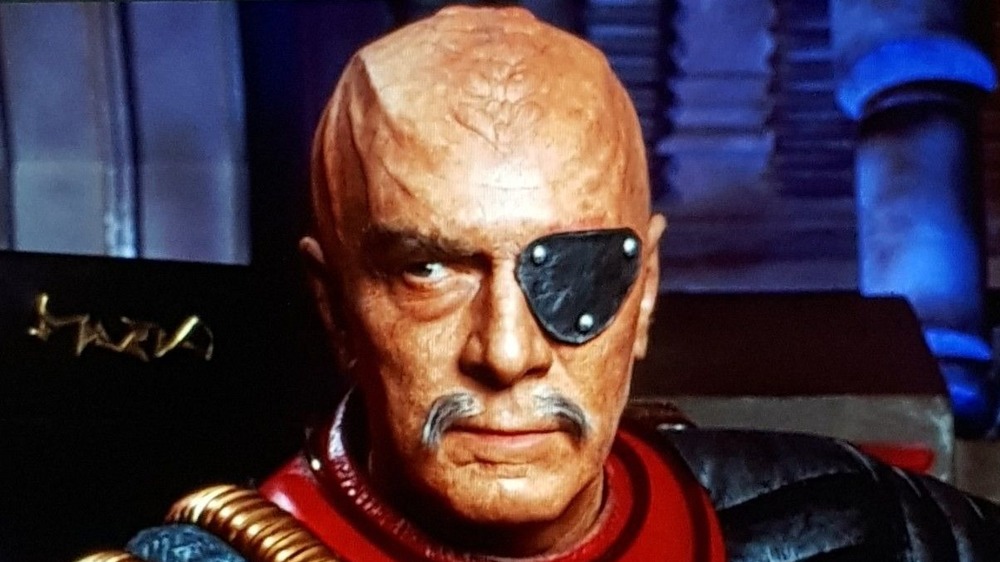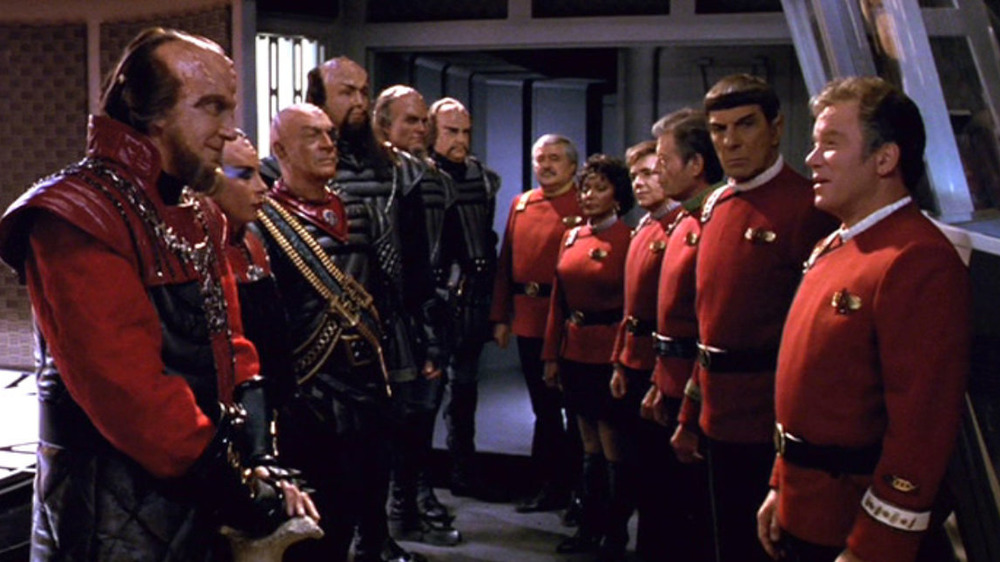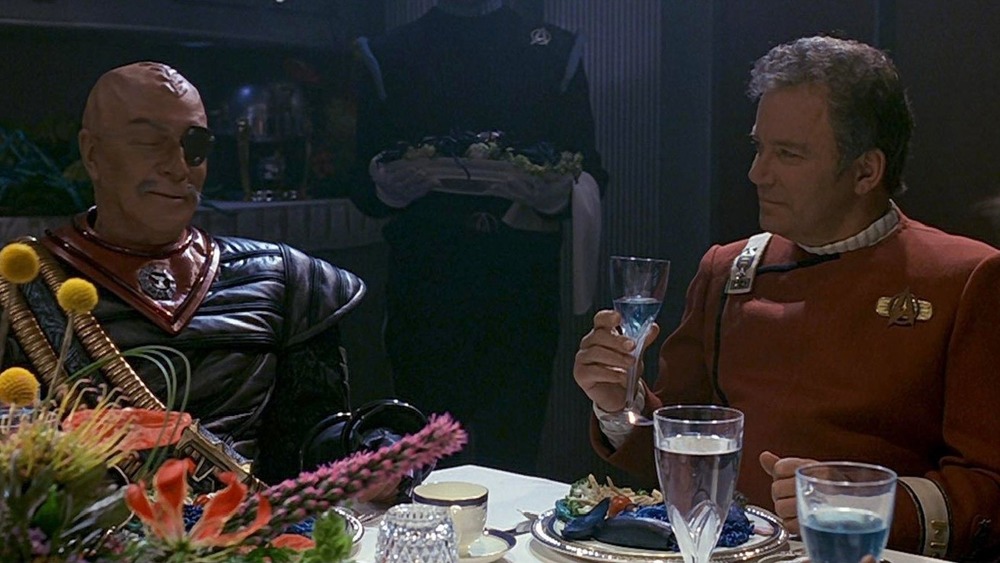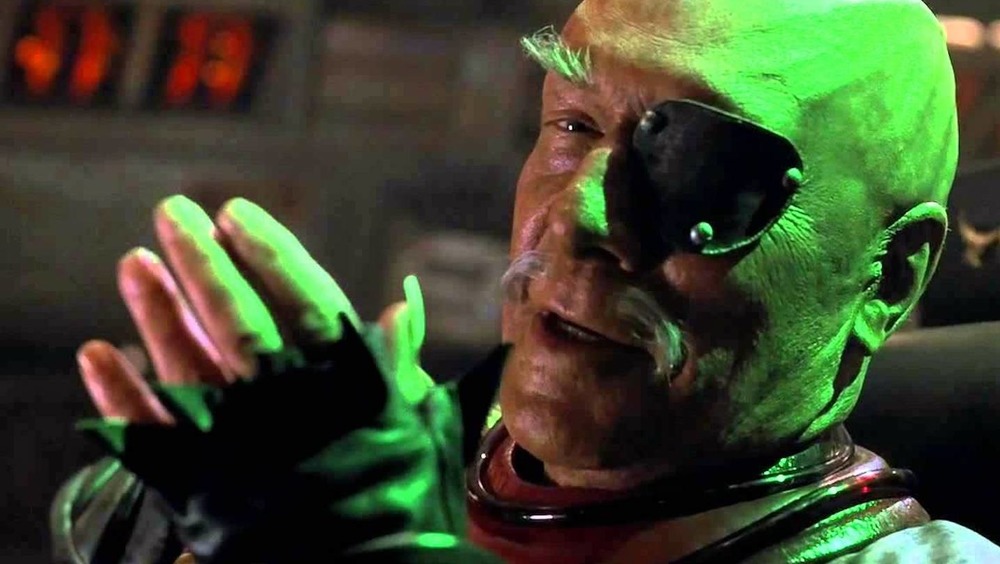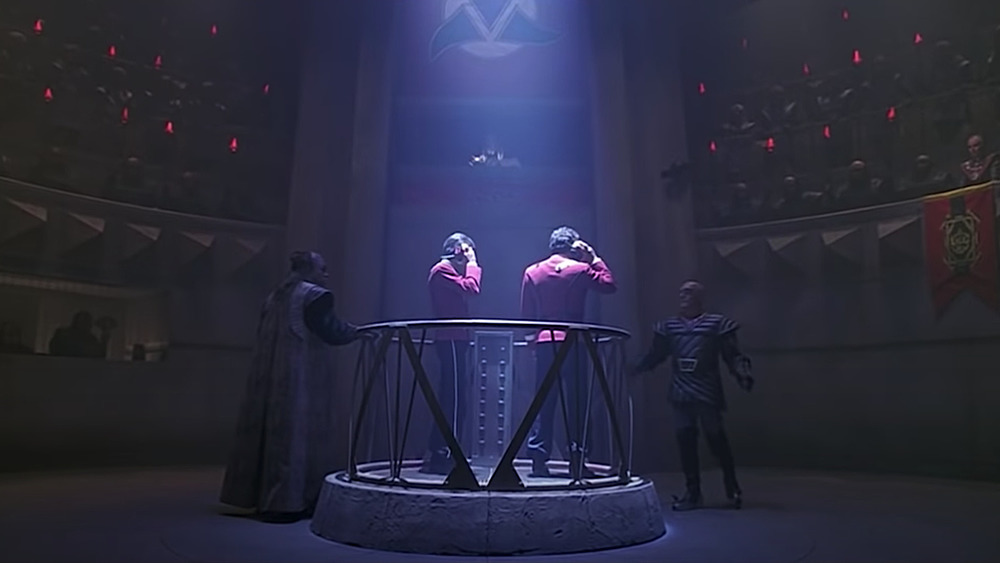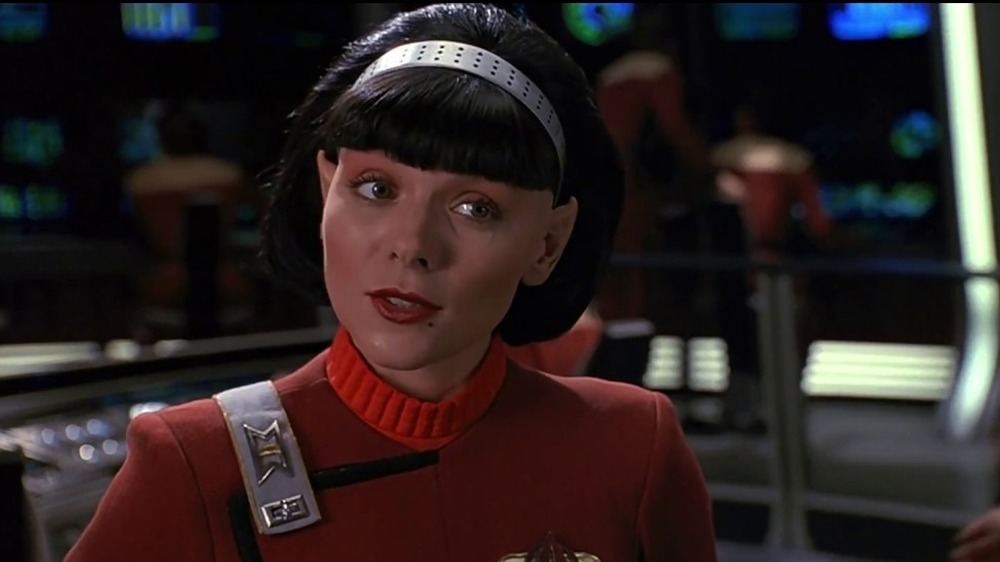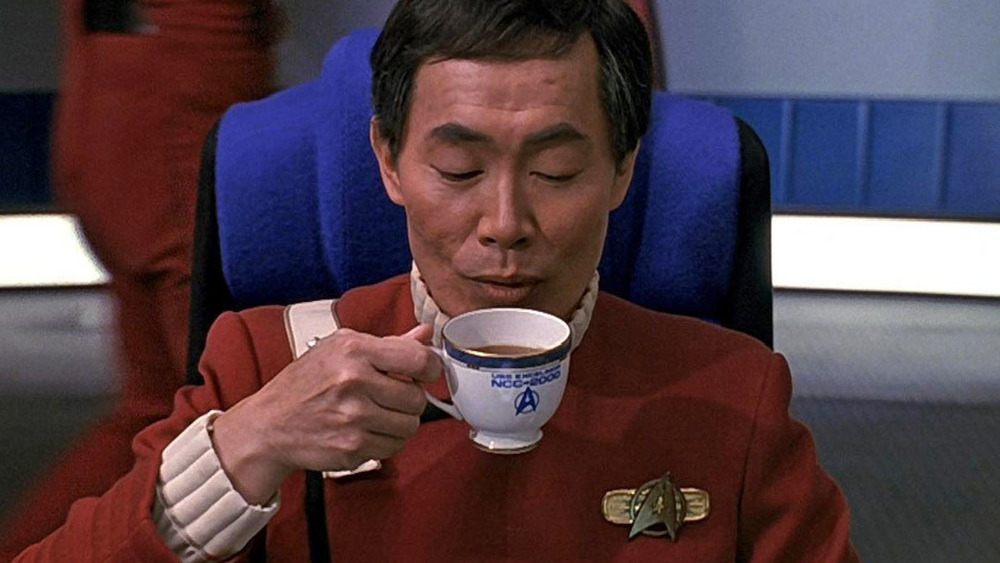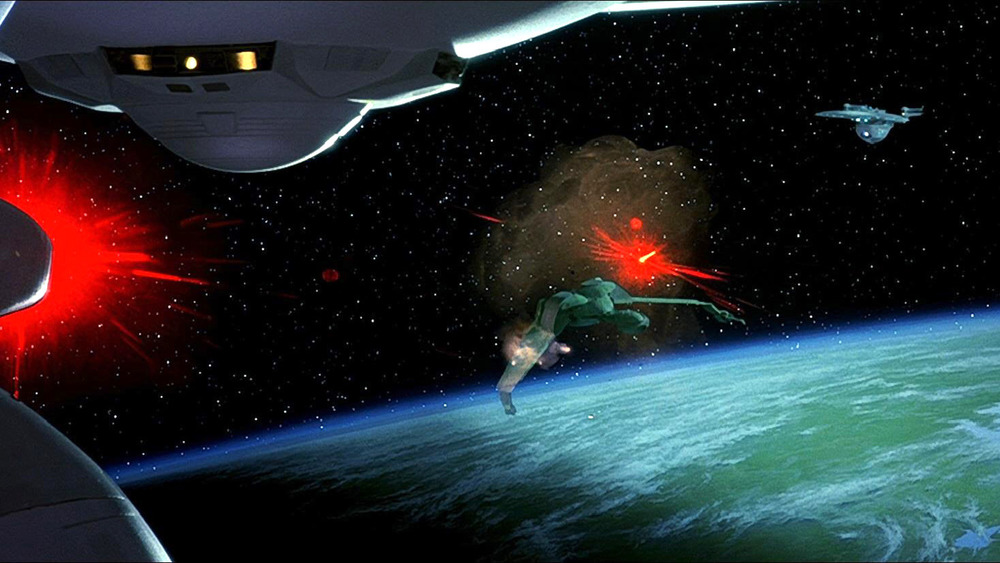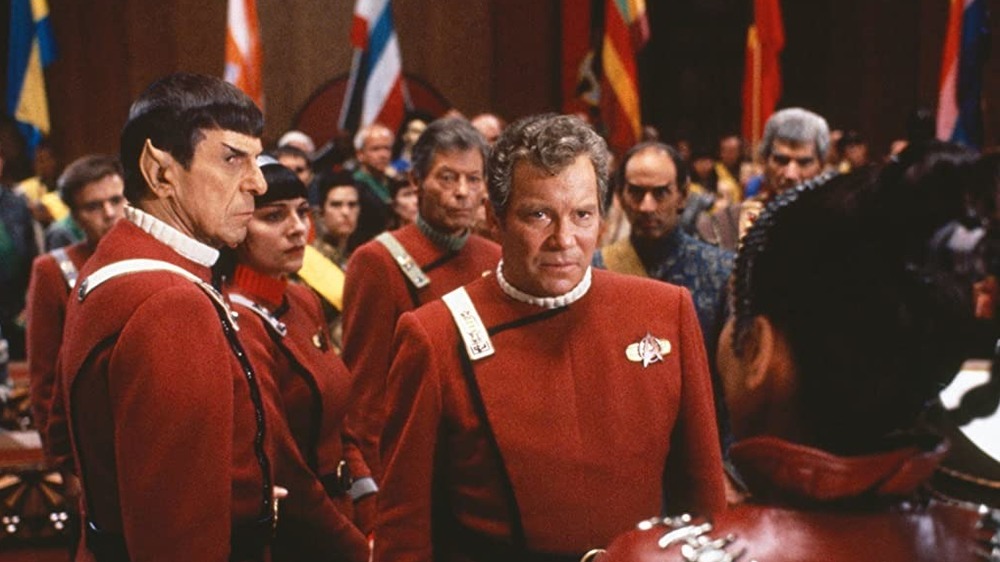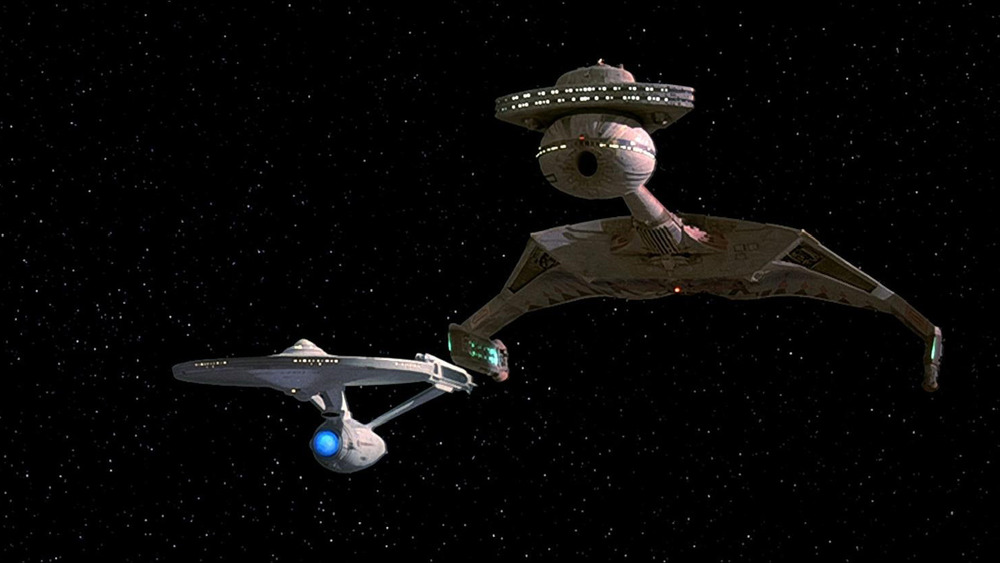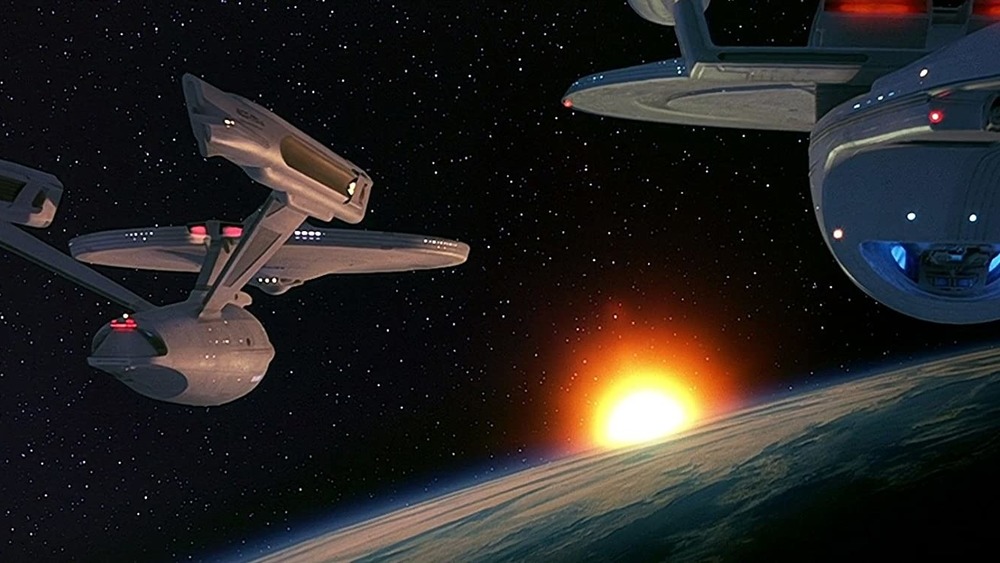Why Star Trek VI: The Undiscovered Country Is The Best Star Trek Movie
The Star Trek phenomenon is now almost 60 years old. While it started on TV — and lately has flourished there once again with Discovery, Picard, and Lower Decks — the franchise also has a long and mostly well-regarded cinematic history, with Star Trek: The Motion Picture debuting in 1979, and regular entries hitting theaters throughout the 1980s and '90s. The movie series took a hiatus after the poorly received Star Trek: Nemesis in 2002, but returned in 2009 with J.J. Abrams' acclaimed reboot, starring Chris Pine, Zachary Quinto, and Zoe Saldana as Kirk, Spock, and Uhura, respectively. Dubbed the "Kelvin" timeline for how it rejiggered events within the existing Star Trek universe, the reboot delivered three films, bowing out in 2016 with Star Trek Beyond. While a number of possible Star Trek films have been discussed since, including an entry by Trek fan Quentin Tarantino, Paramount Pictures has yet to announce anything official.
While Trekkers await news of a new film, they engage in the age-old practice of ranking the existing films. Such rankings invariably place the vaunted Star Trek II: The Wrath of Khan at the top, and one could argue that it is the best in terms of pure cinema. But in honor of the late Christopher Plummer — who played the classic Klingon villain, General Chang, in the film — we argue that Star Trek VI: The Undiscovered Country is the best film embodiment of Star Trek, and everything fans love about the original series.
It best reflects Star Trek's original Cold War allegory
Gene Roddenberry imagined Star Trek as a "Wagon Train to the Stars," with Earth settlers boldly exploring the final frontier of space. But he also conceived of it as a Cold War allegory, one in which the United Federation of Planets represented NATO, the Klingon Empire stood in for the Soviet Union, and the Romulans were the red Chinese. A number of episodes of the original series allegorize Cold War conflicts, including "Errand of Mercy," "Friday's Child," "Elaan of Troyius," "The Omega Glory," and "Balance of Terror."
Producer Harve Bennett's "holy trilogy" – The Wrath of Khan, The Search for Spock, and The Voyage Home – explored the relationships and trials of the Enterprise crew and the sacrifices they made for one another. But when Paramount brought back Wrath of Khan writer/director Nicholas Meyer to make one final film with the original series cast, he and Leonard Nimoy took Star Trek back to its Cold War roots, imagining "the fall of the Berlin Wall in space," and its aftermath. Specifically, they wanted to dramatize the hard work of achieving peace in a world that is used to hate, paranoia, and xenophobia. The plot, about a coup that attempts to derail a galactic peace conference, mirrored the real events of the summer of 1991 so accurately — with Russian hardliners trying to restore the old Soviet Union — that Paramount even tried to rush the film into theaters before it was ready.
It has the most eloquent dialogue
Maybe because he started out as a novelist, Nicholas Meyer has a real gift with dialogue. Sure, he borrows some of the dialogue in his Star Trek movies from classic works of Western Civilization, but he's good at using those works to underscore his themes. Star Trek II, for example, opens with Spock giving Kirk an antique copy of Dickens' A Tale of Two Cities, a novel about sacrifice. Later in the film, Kirk quotes the novel, reflecting on Spock's sacrifice for the greater good. In The Undiscovered Country, Meyer has the Klingon character Chang lay claim to Shakespeare and constantly quote the Bard throughout. The Undiscovered Country also weaves in references from Brave New World, Sherlock Holmes, and Peter Pan.
But Meyer also writes excellent dialogue of his own. The Undiscovered Country is about people confronting the rigidity and prejudice of their own thinking, and the way in which Kirk and Spock acknowledge their own shortcomings and mistakes is very poignant. "How on Earth can history get past people like me?" Kirk asks himself at one point. Later Spock asks, "Is it possible that we two, you and I, have become so old and inflexible that we have outlived our usefulness?" "You're a great one for logic," Kirk responds. "I'm a great one for rushing in where angels fear to tread. We're both extremists." Their self-reflective dialogue allows for meaningful character change that makes The Undiscovered Country the best Star Trek film.
Christopher Plummer plays a classic villain
If you are going to write a script bursting with lines from Shakespeare, then you had better give them to Shakespearean actors. Meyer does just that in The Undiscovered Country, casting Royal Shakespeare Company veteran David Warner as Chancellor Gorkon, a Klingon ambassador trying to forge peace with the Federation, and Christopher Plummer as the villainous Klingon General Chang, who spearheads a conspiracy to sabotage the peace process. Plummer was as famous for his work on the Shakespearean Stage as he was for roles in films such as The Sound of Music, and he is right at home intoning quotes from Hamlet, Henry V, Julius Caesar, and The Merchant of Venice while he taunts Kirk and company.
Plummer gives a famously flamboyant performance here. Star Trek, after all, is a space opera, and opera calls for vigorous portrayal — which Ricardo Montalban understood as Khan in Star Trek II. But while Plummer goes big as Chang, he is fully committed to the role, never mocking it or playing it at a winking reserve, as though embarrassed to be encased in all that sci-fi makeup. In fact, Plummer had been a Star Trek fan when the show debuted in the 1960s. He had also worked with William Shatner in the Canadian theater before Shatner had become a star. The future Captain Kirk was Plummer's understudy in...wait for it...Henry V — just one of the many ways that The Undiscovered Country brings Star Trek full circle.
It has the most impressive cinematography and visual effects
Despite the fact that Industrial Light and Magic worked on both, Star Trek movies were not as renowned for their visual effects as Star Wars. This is partially because viewers forever associated Trek with the low budget aesthetic of the original television show. Still, the movies featured some impressive spectacle — the space battle inside the pink clouds of the Mutara Nebula in Wrath of Khan; the Enterprise self-destructing and burning up in The Search for Spock; the Klingon Bird of Prey hovering over a whaling ship in The Voyage Home.
The Undiscovered Country is the most sustained visual achievement of the original movie series. If the space battles aren't quite as exciting as those in Wrath of Khan, it outdoes the previous films in other ways, as with the mammoth opening explosion of the Klingon mining moon and the giant purple shock wave that engulfs Sulu's ship, the Excelsior. There's a terrific action sequence set on a gravity-disabled Klingon flagship when two masked assassins gun down the Klingons onboard, sending their fuchsia blood floating in neon globules through the zero-G environment. Star Trek VI is also a huge prosthetic show, with more alien masks and makeup on display than the rest of the films combined, giving the galaxy a sense of being diversely populated. Finally, Meyer and cinematographer Hiro Narita elect for low lighting throughout that gives the film a burnished glow, as well as a sense of foreboding and menace.
It has the best complement of guest characters
Every Star Trek movie introduces new characters to the existing mix, and the quality of the films often mirrors the strength of the new characters. For example, Star Trek II added one of cinema's great villains in Khan, as well as the popular half Romulan-half Vulcan Starfleet officer Saavik, played by Kirstie Alley. The wretched Star Trek V, conversely, features Spock's forgettable half brother, Sybok.
Star Trek VI balances out the main cast with a wealth of memorable new faces. In addition to Chang and Gorkon, the movie fills out its large contingent of Klingons with Gorkon's fierce daughter, Azetbur (Rosanna DeSoto), as well as the grandfather of Star Trek: The Next Generation's Worf (played by the same actor, Michael Dorn). Other sharply drawn characters include a shapeshifting alien named Martia (the model Iman), and Kurtwood Smith as the Federation President. Even Christian Slater shows up for a cameo.
Besides Chang, the best new character is Lt. Valeris, Spock's Vulcan protege (a pre-Sex and the City Kim Cattrall), who is loyal to Starfleet in ways that end up haunting Spock. Like Saavik before her — whom she replaced when Alley wasn't available — Valeris has more scenes than most of the Trek regulars, and the movie is better for the freshness and vitality of her character. She and Chang, along with many other new characters, help make the Star Trek universe feel densely and diversely populated.
Sulu gets his own command
Fans had been clamoring to see this on film for a while before it actually happened, as novelizations and other ancillary Trek material had long established Sulu's (George Takei) promotion to captain. It just became a matter of giving him a command (and a gorgeous Starfleet tea set). His ship, the USS Excelsior, had actually been introduced in Star Trek III: The Search for Spock as one of a new generation of starships that would replace the Enterprise. When Kirk goes rogue in that movie, Starfleet sends the Excelsior to apprehend him, but it fails because Scotty has sabotaged the transwarp drive. Despite that, fans found the ship cool, and it was unsurprising to see it show up under Sulu's command a few films later.
Narratively, adding another Starfleet ship widens the scope of the film, and it gives one of the primary original characters something to do besides hang around on the Enterprise bridge. Sulu and the Excelsior feature prominently in the dramatic opening of the film, as well as the exciting climax. As they race at Warp 10 to help the Enterprise save the galactic peace conference, a junior officer warns, "She'll fly apart," to which Sulu barks, "Fly her apart then!" You can practically feel Takei's relish at getting a line this exciting after "yes sirring" Captain Kirk all those years.
The storytelling is first rate
The famous film critic Pauline Kael, reviewing Star Trek II for the New Yorker, wrote, "the pieces of the story fit together beautifully." The same can be said for The Undiscovered Country, an ambitious film that explores a number of themes, and moves the action all over the galaxy, from a doomed Klingon mining moon, to an alien gulag, to a vast ice shelf that threatens to freeze our heroes to death.
The action is breathless and exciting. Star Trek VI also deftly blends genres. Meyer, a Sherlock Holmes aficionado (he wrote The Seven Percent Solution), shoehorns an old-fashioned country house mystery into the larger space opera plot: The Enterprise crew races the clock to figure out who has framed them for an act of international terrorism that has killed the Klingon ambassador and jeopardized the peace conference. Meyer and co-writers Leonard Nimoy and Denny Martin Flynn also add a juicy courtroom trial, an elaborate banquet scene, and a prison escape for good measure, along with all the space battles, phaser fights, and philosophical discussions fans had come to expect. Like the plot-heavy Wrath of Khan before it, somehow the disparate parts don't "fly apart" as the story warp speeds towards its big climax in which all the plot threads are resolved at the big galactic peace conference.
It has the highest stakes
In Star Trek II, Spock saves the Enterprise and her crew at the expense of his life. In Star Trek III, the Enterprise crew returns the favor but sacrifices the ship. In Star Trek IV, the stakes include the survival of Earth and all its people. By The Undiscovered Country, the fate of the entire galaxy hangs in the balance. Can humans and alien species work together to preserve the fragile goal of peace? Or is the galaxy doomed to perpetual war? These are the highest stakes of the series so far, and they account for the great tension in the story, as well as the viewer's heightened investment.
But the movie dramatizes the highest personal stakes of the series as well. The characters do a good job of saving each other in previous movies. But in The Undiscovered Country, they are tasked with saving themselves. Will they be able to see the error of their ways before it's too late? They certainly try. Spock admits that it was "arrogant presumption" on his part that got them into the story's mess in the first place, as well as his belief in the inherent superiority of Vulcans. Kirk meanwhile confesses that he was so used to vilifying Klingons, it never even occurred to him to believe they might actually want peace. "Gorkon had to die before I understood how prejudiced I was," he says. "People can be very frightened of change."
It leans more fully into Star Trek's nautical roots
The starships in The Undiscovered Country feel more like ships at sea, or even submarines, with low lighting and claustrophobic spaces, than the brightly lit flying living rooms of, say, The Next Generation. This fits with Gene Roddenberry's original vision of Starfleet as a navy, with an academy and naval ranks. The officers use nautical directions such as port and starboard. And of course, the U.S.S. Enterprise was meant to be the descendant of the many real ships designated "Enterprise," including the famous WWII aircraft carrier. For his part, Meyer embraced Roddenberry's vision of Star Trek as fictional British naval hero Horatio Hornblower in space. In Star Trek VI, the director leans into the concept even more fully than he had in Star Trek II, putting the crewmen together in cramped bunkrooms, referring to the kitchen as the galley, and using torpedoes during warfare.
All these elements come together in The Undiscovered Country, creating the sense that the Enterprise crew really is out on the open sea, far from any shore, with only each other to depend on. Meyer epitomizes the theme beautifully with Kirk's great final line. When asked for a course heading, he paraphrases Peter Pan: "Second star to the right, and straight on 'til morning." Of course, Peter Pan was an adventure set on ships, but the line also suggests the eternal pull of the horizon, which had always informed the hopeful vision of Star Trek.
It perfectly ends the original series
Star Trek VI is extremely meta, commenting on its own Trekness throughout. In our current age of globalized mass entertainment — in which the boundaries between producers and consumers are more blurred than ever — it's common, even expected, for popular franchises to wink at their fans, referencing elements outside of a given story. Though it wasn't as common in 1991, Star Trek VI engages in the practice throughout. At one point, when Scotty suggests that their situation is so dire that "we're dead," Spock quips, "I've been dead before." Meanwhile, tackling the theme of aging directly engages the cultural jokes about the Enterprise crew saving the galaxy in walkers and wheelchairs.
But the fan service in this film is never at the expense of the story. Nor does the movie try to retcon the franchise to appease some vocal contingent. The only responsibility the filmmakers feel is to make a good final movie, especially after the disappointment of Star Trek V. Star Trek VI sends off the original cast and crew, but it's also a send-off to the fans that made it all possible, the passionate people that saved Star Trek from cancellation and kept it alive in the lean years and through some bad movies. The movie ends the original series with great eloquence and poignancy, while at the same time suggesting that Star Trek will live forever. Its greatest gift to fans is saving the best for last.
